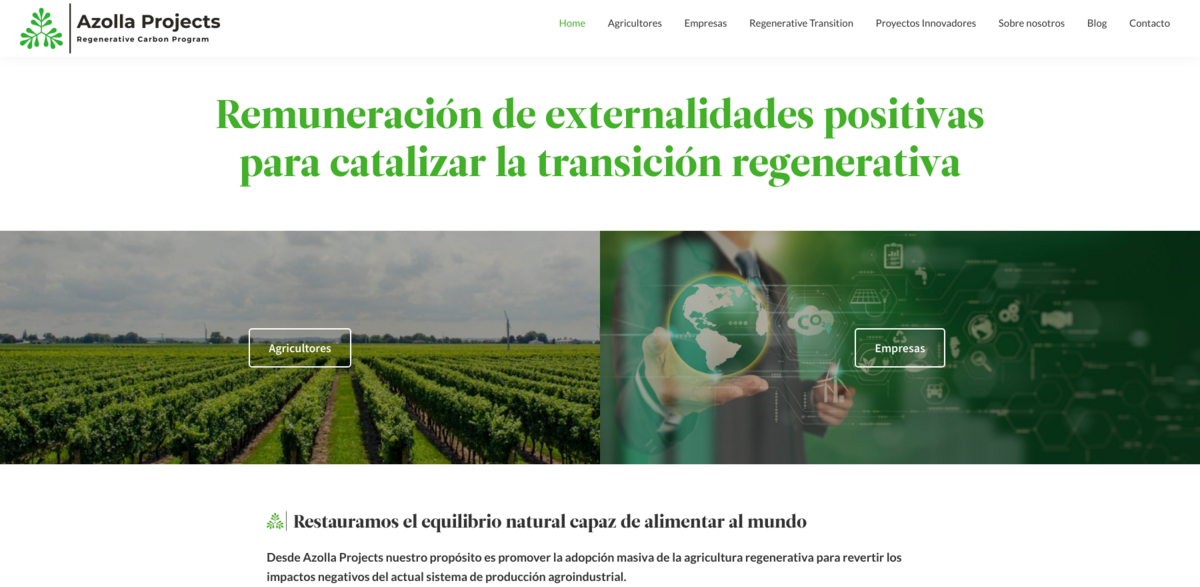What Are Azolla Projects for Carbon Farming?
Azolla Projects focus on promoting the massive adoption of regenerative agriculture to reverse the negative impacts of the current agro-industrial production system. The goal? To help life on Earth endure by restoring the planet’s natural balance. Regenerative agriculture is the key here — it naturally sequesters CO2, turning farms into massive carbon sinks that fight climate change. Plus, it restores the short water cycle, boosts biodiversity, and helps adapt farming to extreme climate events. It’s not just farming; it’s a whole new way of thinking about agriculture and the environment.
Main Benefits of the Azolla Regenerative Carbon Program
The Azolla Regenerative Carbon Program offers farmers a chance to increase income by capturing carbon in their fields — all while making their operations more secure and resilient. Here’s what it brings to the table:
- Reduces soil loss and degradation
- Halts desertification
- Ensures food sovereignty
- Rebalances the water cycle, cutting down water needs and pollution
- Improves biodiversity by reintegrating it into agroecosystems
- Increases farmers’ profitability and helps combat rural depopulation
Understanding the Current Situation of Carbon Credits
The carbon credit market is in flux, undergoing changes and restructuring globally and in Europe. Azolla Projects lead with ethics and trust to bring stability to this evolving market. Greenwashing scandals have pushed the market to clean up its act and organize better. Europe is working on new regulatory frameworks, including the Carbon Removal and Carbon Farming (CRCF) certification and the Carbon Border Adjustment Mechanism (CBAM), which aims to prevent companies from shifting production to countries with looser carbon rules. Meanwhile, EU member states are setting up their own voluntary carbon markets.
Azolla’s Role in the Regenerative Transition
Azolla Projects don’t just talk the talk — they design integrated projects that combine agricultural production with ecosystem restoration. Their personalized approach improves biodiversity, optimizes natural resource use, and supports socio-economic development. They’re also part of innovative initiatives like Carbon Farming Med, launching in January 2024 to create a Mediterranean agricultural carbon market, and AgriRegenCarbon, a major consortium involving cooperatives and foundations pushing regenerative agriculture forward.
Types of Carbon Credits Offered by Azolla
Azolla offers different kinds of carbon credits, each with its own focus:
- Emission Reduction Credits: Represent a reduction of one ton of CO2 or other greenhouse gases that would have been emitted.
- Carbon Credits: Represent the removal of one ton of CO2 already in the atmosphere, safely stored to prevent global warming.
- Regenerative Credits: Holistic credits rewarding not just carbon capture but also biodiversity enhancement, water footprint reduction, and socio-economic benefits for farmers.
Positive Impacts of the Azolla Regenerative Carbon Program on Sustainable Development Goals (SDGs)
- SDG 2: Zero Hunger — Ensuring food sovereignty and sustainable agriculture
- SDG 6: Clean Water and Sanitation — Rebalancing the water cycle and reducing pollution
- SDG 13: Climate Action — Capturing carbon and combating climate change
- SDG 15: Life on Land — Improving biodiversity and halting desertification
- SDG 8: Decent Work and Economic Growth — Increasing farmers’ profitability and supporting rural communities
Why Join the Regenerative Agriculture Movement?
Jumping into regenerative agriculture means learning new tools and adapting your practices — but it’s worth it. While transitioning, farmers get economic compensation for carbon capture and save on resources like machinery, fuel, and fertilizers. Plus, it’s a smart move to stay ahead of the new Common Agricultural Policy (CAP) sustainability measures. Regenerative agriculture combines traditional knowledge with scientific advances, focusing on restoring ecosystems for the benefit of farmers, production, the planet, and society. Practices include improved water management, mixed livestock systems, cover crops, organic fertilizers, agroforestry, and reducing tillage. It’s about working with nature, not against it — and the rewards go beyond just the environment.





















